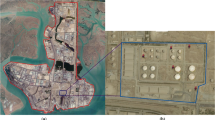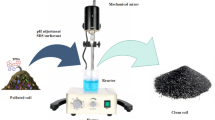Abstract
Low solubility of certain hydrophobic soil contaminants limits remediation process. Surface-active compounds can improve the solubility and removal of hydrophobic compounds from contaminated soils and, consequently, their biodegradation. Hence, this paper aims to study desorption efficiency of oil from soil of SPB1 lipopeptide biosurfactant. The effect of different physicochemical parameters on desorption potency was assessed. Taguchi experimental design method was applied in order to enhance the desorption capacity and establish the best washing parameters. Mobilization potency was compared to those of chemical surfactants under the newly defined conditions. Better desorption capacity was obtained using 0.1 % biosurfacatnt solution and the mobilization potency shows great tolerance to acidic and alkaline pH values and salinity. Results show an optimum value of oil removal from diesel-contaminated soil of about 87 %. The optimum washing conditions for surfactant solution volume, biosurfactant concentration, agitation speed, temperature, and time were found to be 12 ml/g of soil, 0.1 % biosurfactant, 200 rpm, 30 °C, and 24 h, respectively. The obtained results were compared to those of SDS and Tween 80 at the optimal conditions described above, and the study reveals an effectiveness of SPB1 biosurfactant comparable to the reported chemical emulsifiers. (1) The obtained findings suggest (a) the competence of Bacillus subtilis biosurfactant in promoting diesel desorption from soil towards chemical surfactants and (b) the applicability of this method in decontaminating crude oil-contaminated soil and, therefore, improving bioavailability of hydrophobic compounds. (2) The obtained findings also suggest the adequacy of Taguchi design in promoting process efficiency. Our findings suggest that preoptimized desorption process using microbial-derived emulsifier can contribute significantly to enhancement of hydrophobic pollutants' bioavailability. This study can be complemented with the investigation of potential role in improving the biodegradation of the diesel adsorbed to the soil.






Similar content being viewed by others
References
Abalos A, Vinas M, Sabate J, Manresa MA, Solanas AM (2004) Enhanced biodegradation of Casablanca crude oil by a microbial consortium in presence of a rhamnolipid produced by Pseudomonas aeruginosa AT10. Biodegradation 15:249–260
Abdul AA, Gibson TL (1991) Laboratory studies of surfactant-enhanced washing of biphenyl from sandy material. Environ Sci Technol 25(4):665–671
Abouseoud M, Amrane A, Yataghene EA, Maachi R (2010a) Effect of pH and salinity on the emulsifying and solubilizing capacity of a biosurfactant produced by Pseudomonas fluorescens. J Hazard Mater 180:131–136
Abouseoud M, Yataghene A, Amrane A, Maachi R (2010b) Production of a biosurfactant by Pseudomonas fluorescens—solubilizing and wetting capacity. Chem Eng Technol 20:291–296
Bai G, Brusseau ML, Miller RM (1997) Biosurfactant-enhanced removal of residual hydrocarbon from soil. J Cont Hydrol 25:157–170
Bai G, Brusseau ML, Miller RM (1998) Influence of cation type, ionic strength, and pH on solubilization and mobilization of residual hydrocarbon by a biosurfactant. J Cont Hydrol 30:265–279
Batista RM, Rufino RD, Luna JM, Souza JEG, Sarubbo LA (2011) Effect of medium components on the production of biosurfactant from Candida tropicallis applied to the removal of hydrophobic contaminants in soil. Water Environ Res (in press)
Bordas F, Lafrance P (2001) Utilisation de biosurfactants (rhamnolipides) pour le traitement d'un sol sableux contaminé par le pyrène; Essais en colonnes de sol. Étude Gest Sols 8(3):181–188
Bordoloi NK, Konwar BK (2009) Bacterial biosurfactant in enhancing solubility and metabolism of petroleum hydrocarbons. J Hazard Mater 170:495–505
Cameotra SS, Singh P (2008) Bioremediation of oil sludge using crude biosurfactants. Int Biodeterior Biodegrad 62:274–280
Chang J-S, Radosevich M, Jin Y, Cha DK (2004) Enhancement of phenanthrene solubilization and biodegradation by trehalose lipid biosurfactants. Environ Toxicol Chem 23:2816–2822
Collins C (2007) Implementing phytoremediation of petroleum hydrocarbons, Methods in biotechnology 23:99-108. Humana Press, New York. ISBN 1-58829-541-9
Dayeh VR, Chow SL, Schirmer K, Bols NC (2004) Evaluating the toxicity of Triton X-100 to protozoan, fish, and mammalian cells using fluorescent dyes as indicators of cell viability. Ecotoxicol Environ Saf 57:375–382
Franzetti A, Caredda P, Ruggeri C, La Colla P, Tamburini E, Papacchini M, Bestetti G (2009) Potential applications of surface active compounds by Gordonia sp. strain BS29 in soil remediation technologies. Chemosphere 75(6):801–807
Franzetti A, Gandolfi I, Bestetti G, Smyth TJP, Banat IM (2010) Production and applications of trehalose lipid biosurfactants. Eur J Lipid Sci Technol 112(6):617–627
Ghojavand H, Vahabzadeh F, Roayaei E, Shahraki AK (2008) Production and properties of a biosurfactant obtained from a member of the Bacillus subtilis group (PTCC 1696). J Colloid Inter Sci 324:172–176
Ghribi D, Abdelkefi L, Boukadi H, Elleuch M, Ellouze-Chaabouni S, Tounsi S (2011a) The impact of the Bacillus subtilis SPB1 biosurfactant on the midgut histology of Spodoptera littoralis (Lepidoptera: Noctuidae) and determination of its putative receptor. J Inver Pathol 109(2):183–186
Ghribi D, Abdelkefi-Mesrati L, Mnif I, Kammoun R, Ayadi I, Saadaoui I, Maktouf S, Chaabouni-Ellouze S (2012a) Investigation of antimicrobial activity and statistical optimization of Bacillus subtilis SPB1 biosurfactant production in solid-state fermentation. J Biomed Biotechnol. doi:10.1155/2012/373682
Ghribi D, Elleuch M, Abdelkefi LM, Ellouze-Chaabouni S (2012b) Evaluation of larvicidal potency of Bacillus subtilis SPB1 biosurfactant against Ephestia kuehniella (Lepidoptera: Pyralidae) larvae and influence of abiotic factors on its insecticidal activity. J Stored Prod Res 48:68–72
Ghribi D, Elleuch M, Abdelkefi-Mesrati L, Boukedi H, Ellouze-Chaabouni S (2012c) Histopathological effects of Bacillus subtilis SPB1 biosurfactant in the midgut of Ephestia kuehniella (Lepidoptera: Pyralidae) and improvement of its insecticidal efficiency. J Plant Dis Protect 119(1):24–29
Ghribi D, Ellouze-Chaabouni S (2011) Enhancement of Bacillus subtilis lipopeptide biosurfactants production through optimization of medium composition and adequate control of aeration. Biotechnol Res Int. doi:10.4061/2011/653654
Ghribi D, Mnif I, Boukedi H, Radhouan K, Chaabouni-Ellouze S (2011b) Statistical optimization of medium components for economical production of Bacillus subtilis surfactin, a biocontrol agent for the olive moth Prays oleae. Afr J Microbiol Res 5(27):4927–4936
Gong M, Wang J-D, Zhang J, Yang H, Lu X-F, Pei Y, Cheng J-Q (2006) Study of the antifungal ability of Bacillus subtilis strain PY-1 in vitro and identification of its antifungal substance (iturin A). Acta Biochim Biophys 38:233–240
Han M, Ji G, Ni J (2009) Washing of field weathered crude oil contaminated soil with an environmentally compatible surfactant, alkyl polyglucoside. Chemosphere 76(5):579–586
Huesemann MH (1997) Incomplete hydrocarbon biodegradation in contaminated soils: limitations in bioavailability or inherent recalcitrance. Bioremed J 1(1):27–39
Huszcza E, Burczyk B (2003) Biosurfactant production by Bacillus coagulans. J Surfactant Deterg 6:61–64
Joshi S, Bharucha C, Desai AJ (2008) Production of biosurfactant and antifungal compound by fermented food isolate Bacillus subtilis 20B. Biores Technol 99:4603–4608
Kalali A, Ebadi T, Rabbani A, Moghaddam SS (2011) Response surface methodology approach to the optimization of oil hydrocarbon polluted soil remediation using enhanced soil washing. Int J Environ Sci Technol 8(2):389–400
Kang SW, Kim YB, Shin JD, Kim EK (2010) Enhanced biodegradation of hydrocarbons in soil by microbial biosurfactant, sophorolipid. Appl Biochem Biotechnol 160:780–790
Kuyukina MS, Ivshina IB (2010) Rhodococcus biosurfactants: biosynthesis, properties, and potential applications. In: Alvarez HM (ed) Biology of Rhodococcus. Springer, Berlin
Kuyukina MS, Ivshina IB, Makarov SO, Litvinenko LV, Cunningham CJ, Philp JC (2005) Effect of biosurfactants on crude oil desorption and mobilization in a soil system. Recent Ad Bioremed 31(2):155–161
Lai C-C, Huang Y-C, Wei Y-H, Chang J-S (2009) Biosurfactant-enhanced removal of total petroleum hydrocarbons from contaminated soil. J Hazard Mater 167(1–3):609–614
Liu H, Shi Z, Gao N, Sun Q (2008) Promotion of biosurfactants on washing of PCBs from contaminated soil. Abstr J Biotechnol 136:678–707
Luna JM, Rufino RD, Albuquerque CDC, Sarubbo LA, Campos-Takaki GM (2011) Economic optimized medium for tensio-active agent production by Candida sphaerica UCP0995 and application in the removal of hydrophobic contaminant from sand. Int J Mol Sci 12:2463–2476
Luna JM, Sarubbo LA, Campos-Takaki GM (2009) A new biosurfactant produced by Candida glabrata UCP1002: characteristics of stability and application in oil recovery. Braz Arch Biol Technol 52:785–793
Mc-Cray JE, Bai G, Maier RM (2001) Biosurfactant-enhanced solubilization of NAPL mixtures. J Contam Hydrol 48:45–68
Michaud L, Lo Giudice A, Saitta M, De Domenico M, Bruni V (2004) The biodegradation efficiency on diesel oil by two psychrotrophic Antarctic marine bacteria during a two-month-long experiment. Mar Pollut Bull 49:405–409
Mnif I, Besbes S, Ellouze R, Ellouze-Chaabouni S, Ghribi D (2012c) Improvement of bread quality and bread shelf-life by Bacillus subtilis biosurfactant addition. Food Sci Biotechnol 21(4):1105–1112
Mnif I, Besbes S, Ellouze-Ghorbel R, Ellouze-Chaabouni S, Ghribi D (2013a) Improvement of bread dough quality by Bacillus subtilis SPB1 biosurfactant addition: optimized extraction using response surface methodology. J Sci Food Agric. doi:10.1002/jsfa.6139
Mnif I, Elleuch M, Ellouze Chaabouni S, Ghribi D (2013b) Bacillus subtilis SPB1 biosurfactant: production optimization and insecticidal activity against the carob moth Ectomyelois ceratoniae. Crop Prot 50:66–72
Mnif I, Ellouze-Chaabouni S, Ghribi D (2012b) Response surface methodological approach to optimize the nutritional parameters for enhanced production of lipopeptide biosurfactant in submerged culture by B. subtilis SPB1. J Adv Scient Res 3(1):87–94
Mnif I, Ellouze-Chaabouni S, Ghribi D (2012c) Economic production of Bacillus subtilis SPB1 biosurfactant using local agro-industrial wastes and its application in enhancing solubility of diesel. J Chem Technol Biotechnol 88(5):779–787
Moran AC, Olivera N, Commendatore M, Esteves JL, Siñeriz F (2000) Enhancement of hydrocarbon waste biodegradation by addition of a biosurfactant from Bacillus subtilis O9. Biodegradation 11:65–71
Mulligan CN, Yong RN, Gibbs BF (2001) Surfactant-enhanced remediation of contaminated soil: a review. Eng Geol 60:371–380
Muthusamy K, Gopalakrishnan S, Ravi TK, Sivachidambaram P (2008) Biosurfactants: properties, commercial production and application. Curr Sci 94:736–747
Olivera FL, Caron GR, Brandelli A (2004) Bacteriocin production by Bacillus licheniformis strain P40 in cheese whey using response surface methodology. Biochem Eng J 21:53–58
Pacwa-Plociniczak M, Plaza GA, Piotrowska-Seget Z, Cameotra SS (2011) Environmental applications of biosurfactants: recent advances. Int J Mol Sci 12:633–654
Pavlic Z, Cifrek ZV, Puntaric D (2005) Toxicity of surfactants to green microalgae Pseudokirchneriella subcapitata and Scenedesmus subspicatus and to marine diatoms Phaeodactylum tricornutum and Skeletonema costatum. Chemosphere 61:1061–1068
Peace Stuart G (1995) Taguchi methods, a hands-on approach to quality engineering. Addison-Wesley Publishing Company, Reading
Pennell KD, Jin M, Abriola LM, Pope GA (1994) Surfactant enhanced remediation of soil columns contaminated by residual tetrachloroethylene. J Contam Hydrol 16:35–53
Phadke MS (1989) Quality engineering using robust design. Prentice Hall, Englewood Cliffs
Rahman KSM, Banat IM, Thahira J, Thayumanavan T, Lakshmanaperumalsamy P (2002) Bioremediation of gasoline contaminated soil by a bacterial consortium amended with poultry litter, coir pith and rhamnolipid biosurfactant. Biores Technol 81:25–32
Ron EZ, Rosenberg E (2002) Biosurfactants and oil bioremediation. Curr Opi Biotech 13:249–252
Ross PJ (1987) Taguchi techniques for quality engineering. McGraw-Hill, New York, pp 123–124
Sen R, Swaminathan T (1997) Application of response-surface methodology to evaluate the optimum environmental conditions for the enhanced production of surfactin. App Microbiol Biotechnol 47:358–363
Taguchi G (1987) System of experimental design, vol. 1. Quality Resources, New York, pp 108–115
Taguchi G (1990) Introduction to quality engineering: designing quality into products and processes. Asian Productivity Organization, Tokyo
Thimon L, Peypoux F, Michel G (1992) Interactions of surfactin, a biosurfactant from Bacillus subtilis with inorganic cations. Biotechnol Lett 14(8):713–718
Urum K, Grigson S, Pekdemir T, McMenamy S (2006) A comparison of the efficiency of different surfactants for removal of crude oil from contaminated soils. Chemosphere 62:1403–1410
Urum K, Pekdemir T (2004) Evaluation of biosurfactants for crude oil contaminated soil washing. Chemosphere 57:1139–1150
Urum K, Pekdemir T, Gopur M (2003) Optimum conditions for washing of contaminated soil with biosurfactant solutions. Inst Chem Eng 81(3):203–209
Vipulanandan C, Ren X (2000) Enhanced solubility and biodegradation of naphthalene with biosurfactant. J Environ Eng 7:629–634
Whang L-M, Liu P-WG, Ma C-C, Cheng S-S (2008) Application of biosurfactants, rhamnolipid, and surfactin, for enhanced biodegradation of diesel-contaminated water and soil. J Hazard Mater 151:155–163
Acknowledgments
This work has been supported by grants from the Tunisian Ministry of Higher Education, Scientific Research, and Technology.
Author information
Authors and Affiliations
Corresponding author
Additional information
Responsible editor: Philippe Garrigues
Rights and permissions
About this article
Cite this article
Mnif, I., Sahnoun, R., Ellouze-Chaabouni, S. et al. Evaluation of B. subtilis SPB1 biosurfactants' potency for diesel-contaminated soil washing: optimization of oil desorption using Taguchi design. Environ Sci Pollut Res 21, 851–861 (2014). https://doi.org/10.1007/s11356-013-1894-4
Received:
Accepted:
Published:
Issue Date:
DOI: https://doi.org/10.1007/s11356-013-1894-4




